The Catuvellauni before Rome
The information on this page and the associated resources was created by Giles Penman, PhD student here at the University of Warwick. Giles is currently working on Ancient Greek and Roman imagery on British civil cultural artefacts relating to the Great War and its post-war commemoration, 1914-1939.
The Catuvellauni
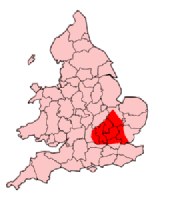
The Catuvellauni (possibly meaning "war-chiefs" in the ancient Gaulish Celtic language) were a tribe or state of south eastern Britain before the Roman conquest, attested by inscriptions into the 4th century AD.
Something of the history and fortunes of the Catuvellauni and their rulers before the conquest can be traced through ancient coins and references in classical histories. They are mentioned, for example, by Cassius Dio, who implies that they led the resistance against the Roman conquest in AD 43. In the 2nd century AD they appear as one of the civitates (client Kingdoms) of Roman Britain in Ptolemy's Geography. In terms of where they were found, they were centred on the town of Verlamion (near modern St Albans) and the surrounding areas of Hertfordshire, Bedfordshire and southern Cambridgeshire. Thus their territory was bordered to the north by the Iceni and Corieltauvi, to the east by the Trinovantes, to the west by the Dobunni and Atrebates, and to the south by the Regnenses and Cantiaci. As such the inhabitants of Warwickshire will at the very least have interacted with these people.
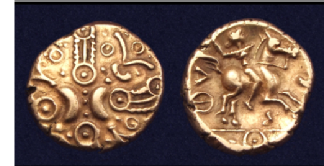
Right is a coin of the Catuvellauni King Tasciovanus, a so-called "Hidden Faces" gold stater minted at Verlamion near modern day St Albans. On the obverse we see stylized crescents and wreaths with hidden faces. On the reverse is a warrior on horse, carrying a carnyx - a sort of bronze wind instrument with a typical S-shape and often with a stylised animal head.
Before Rome - Cassivelaunus and his family
Cassivelaunus
Cassivellaunus, a member of the Catuvellauni tribe appears in Julius Caesar's Commentarii de Bello Gallico, where he was in command of the combined British forces opposing Caesar's second invasion of Britain in 54 BC, although Caesar does not mention Cassivellaunus's tribe.
After Julius Caesar’s unsuccessful invasions in 55 and 54 BC, British tribes began to form substantial economic and political links with the Roman World. Whether or not they were formally recognized as client kings, some British chieftains regarded the Romans as powerful allies. And the Catuvellauni took part in these events.
Strabo (Geog. 4.5.3) refers to British rulers sending embassies to Augustus and making dedications on the Capitol in Rome; there are no details of the date or the circumstances, but Braund has argued that one likely context could have been the formal recognition of client kings. Whether or not they were formally recognized as client kings, some British rulers, like Mandubracius before them, regarded the Roman emperor as a powerful ally, especially at times of factional competition: Augustus (Res Gestae 32) records that two British rulers, Dumnobellaun[us] and Tincom[arus], fled to him.
Tasciovanus
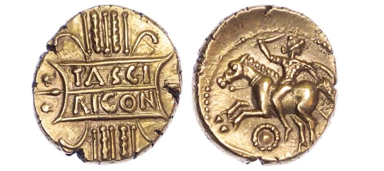 Tasciovanus succeed Cassivellaunus and appears to have become king of the Catuvellauni ca. 20 BC. Although only known from numismatic (coin) evidence, he ruled from Verlamion (the site of modern-day St Albans). The Romans called this site Verulamium. He is believed to have moved the tribal capital to that site from an earlier settlement, near modern-day Wheathampstead. For a brief period c. 15–10 BC he issued coins from Camulodunum (Colchester), apparently supplanting Addedomarus of the Trinovantes as ruler there.
Tasciovanus succeed Cassivellaunus and appears to have become king of the Catuvellauni ca. 20 BC. Although only known from numismatic (coin) evidence, he ruled from Verlamion (the site of modern-day St Albans). The Romans called this site Verulamium. He is believed to have moved the tribal capital to that site from an earlier settlement, near modern-day Wheathampstead. For a brief period c. 15–10 BC he issued coins from Camulodunum (Colchester), apparently supplanting Addedomarus of the Trinovantes as ruler there.
The coin (right) is a gold stater of Tasciovanus, ca.25 BC – AD 9. The obverse reads TASCI / RICON written on stylized tablet, with a vertical wreath. The reverse shows a horseman charging left, holding a sword and shield. Tasciovanus was the first king to mint coins at Verlamion, beginning ca 20 BC. Evidence of his expansion to the east is found in coins ca. 15–10 BC minted in Camulodunum (modern Colchester). This advance was given up, possibly under pressure from Rome, and a later series of coins were again minted at Verulamium.
Cunobelinus and new Roman Wealth
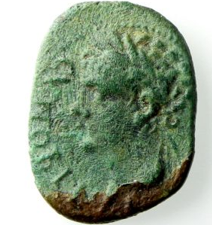
Tasciovanus’ son Cunobelinus maintained throughout his long reign (ca. AD 10– 40) a skilful balance between the two bitterly opposing factions, those for, and those against, Rome. Right is a bronze coin of Cunobelinus from ca.AD 8-41. From c. 20 BC there were significant changes in the coinage of the Southern and Eastern Kingdoms. The imagery on the coins adopted a new set of motifs, closely following the coinage of Augustus, such as laureate portrait heads. Some issues also began to carry inscriptions: the meaning of all the inscriptions is far from clear, but some are the names of rulers known from other sources. A small number of issues bear the name with the Latin title rex. Others have the Latin formula for claimed ancestral descent, F (for filius). Thus, in the Eastern Kingdom, some coins bear the inscriptions cunobelinus and tasciovani. Tasciovanus is known only from such coins, but Cunobelinus is the person known to us from the Roman historian Suetonius as rex Britannorum - King of the Britons - (Caligula 44.2) and also mentioned by Cassius Dio (Hist. lx. 20). Little is known of Cunobelinus's life, but his name survived into British legend, culminating in William Shakespeare's playCymbeline. Geoffrey of Monmouth says he was brought up at the court of Augustus and willingly paid tribute to Rome.
Links with Rome were often beneficial. Despite Caesar’s demand for annual payments, the archaeological evidence suggests that wealth was flowing from the Roman world into Britain. In the decades after his expeditions, there are significant changes in the coinage of south-eastern England. A new series of coins began to be produced whose change of colour from the yellow gold of the old coinage to a red gold shows that Rome was its new source. Large quantities of silver also began to appear, again deriving from Roman bullion and coinage, and this was the source of new silver coin issues in many parts of south-eastern England; some silver circulated in other forms, such as the Augustan silver cups found in the Welwyn and Welwyn Garden City burials.
The historical sources, together with the archaeological evidence of the coins and the burials, clearly demonstrate the existence of powerful ruling lineages in south-eastern England, but the precise nature of that power is unclear.
Relations with Rome - a new material culture
The classical sources naturally concentrate on their relationships with Rome, and so we know that they were able to raise and lead armies, to negotiate peace and give and take hostages; power could be inherited within the lineage and was the subject of factional competition, so Rome could be a powerful ally for those under internal pressure.
What is not clear is how these lineages had achieved such positions, or the real extent of their powers: the use of the title rex and the occasional reference to them as kings in the historical sources says more about the classical perception of such rulers than about the reality of their rule. The concept of the Eastern and Southern Kingdoms is rooted in the distribution of coins, but the relationship between coins and rulers, or between coins and polities, is uncertain.
Some of the coins also bear inscriptions that can be interpreted as the names of places, whether of mints or of other significant locations. In the Eastern Kingdom, Camulodunum (Colchester) and Verulamium (St Albans) are named, and in the Southern Kingdom, Calleva (Silchester). These were unlike the nucleated centres of population but were important new sites, apparently founded in the second half of the first century BC in areas with little previous occupation.
Apart from the gold and silver, other items from the classical world also reached Britain. Italian wine had been imported from the late second century, as noted earlier, but the volume of imported ceramics grew considerably towards the end of the first century BC.
Wine from Italy and Spain, and olive oil from Spain, were reaching south-eastern England. The silver cups from the Welwyn and Welwyn Garden City burials may have been used for drinking such wine. Other imports included flagons from central Gaul and Italian-type terra sigillata, but the largest volume of imports came from the Gallo-Belgic industries founded in northern Gaul after about 15 BC.
These products represented a fusion of Roman and late La Tène types (La Tène is the name given to the cultural style normally associated with the celts and indigenous European and British populations) such as platters and beakers; they were startlingly different from the products of the indigenous tradition and were widely copied in Britain. The distribution of Gallo-Belgic imports shows marked concentrations in central southern and in south-eastern England, roughly coincident with the Southern and Eastern Kingdoms defined by the coinage, but with other clusters in south-western and eastern England, where the imports may have arrived independently or have been distributed onwards from the south-east.
Though most attention has been paid to the amphorae and other ceramics, other innovations suggest a more complex pattern of interactions across the Channel. The inscribed coinage shows a familiarity not only with Latin, but also with literacy more generally. Other signs of literacy in pre-conquest contexts exist, though they are not frequent, including styli and graffiti on pottery, and a probably just post-conquest grave at Stanway, Colchester, which contained an inkwell has argued that literacy and its uses must have been familiar to Britain through contact with the literate societies of Roman Gaul, but that it was adopted only on a limited basis. Another innovation in Britain was the adoption of Roman-style toilet equipment; this suggests a new concern with the adornment of the body, though the precise form that that took is uncertain.
Cunobelinus' family and the Catuvellauni
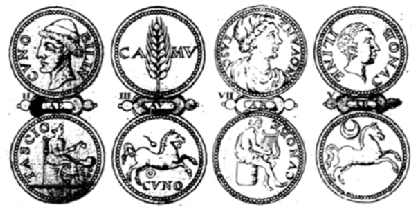 Epaticcus, a brother of Cunobelinus, expanded his influence into the territory of the Atrebates in the early AD 20s, taking the Atrebatan capital Calleva (Silchester) by about AD 25. He continued to expand his territory until his death in about AD 35.
Epaticcus, a brother of Cunobelinus, expanded his influence into the territory of the Atrebates in the early AD 20s, taking the Atrebatan capital Calleva (Silchester) by about AD 25. He continued to expand his territory until his death in about AD 35.
Against Rome
Cunobelinus’ eldest son Togodumnus inherited the throne and with his brother Caratacus took a stance against Rome.
However a third brother, Adminius, had been given the north-east tip of Kent, which included the only land-locked harbour along the south-east coast and the Wantsum Channel into the Thames Estuary. This area included the Cantiaci tribe.
In AD 35, Caratacus took over from Epaticcus and the Atrebates recovered some of their territory under Verica.
Cunobelius exiled Adminius in AD 39/40 and he fled to the Emperor Gaius ‘Caligula’ (Suet. Caligula 44). Adminius may have persuaded Caligula that Britain was vulnerable to attack and that an invasion would be an even more famous victory for him. It is further likely that the capture of the British prince was the germ of Caligula's initiative to launch an invasion of Britain, although the invasion never happened (see here).
Cunobelinus died about AD 40. Philip Crummy has suggested the Lexden Tumulus on the outskirts of Colchester as his tomb.
According to the Roman historian Suetonius, Rome's refusal to return the fugitive Adminius to his father was one of the contributory factors to growing anti-Roman sentiment in Britain, which necessitated Claudius' successful invasion of that land in AD 43 (Suet. Claudius 17).
Caratacus and Verica
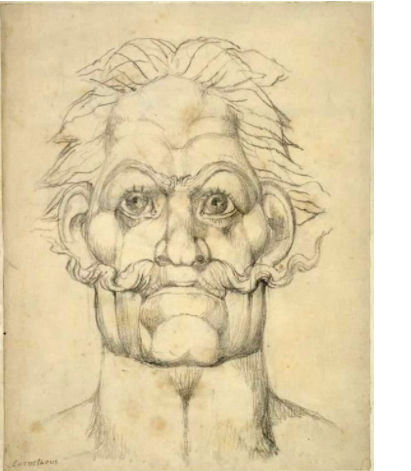
Caratacus's name appears as both Caratacus and Caractacus in manuscripts of Tacitus, and as Καράτακος and Καρτάκης in manuscripts of Dio. Older reference works tend to favour the spelling "Caractacus", but modern scholars agree, based on historical linguistics and source criticism, that the original Common Brittonic form was *Karatākos, cognate with Welsh Caradog, Breton Karadeg, and Irish Carthach, meaning "loving, beloved, dear; friend". Left is a picture of Caratacus by William Blake - one of Blake's 'Visionary portraits'.
After Epaticcus died in about AD 35, the Atrebates, under Verica, regained some of their territory, but it appears Caratacus completed the conquest some time after AD 40. Cassius Dio tells us Verica was ousted by Caratacus, fled to Rome, and appealed to the emperor Claudius for help. This was the excuse used by Claudius to launch his invasion of Britain in the summer of 43 (Dio Cassius Roman History 60.19).
"While these events were happening in the city, Aulus Plautius, a senator of great renown, made a campaign against Britain; for a certain Bericus (sic), who had been driven out of the island as a result of an uprising, had persuaded Claudius to send a force thither."
After the invasion, Verica may have been restored as king, but this is not attested in the historical or archaeological record. In any case a new ruler for the region, Cogidubnus, soon appeared. Cogidubnus may have been an heir of Verica who by this time would have been very elderly indeed.
The Romans arrive AD43
Dio tells us that, by this stage, Cunobelinus was dead, and Togodumnus and Caratacus led the initial resistance to the invasion in Kent. They were defeated by Plautius in two crucial battles on the rivers Medway and Thames - see more discussion on these events here. He also tells us that the Bodunni, a tribe or kingdom who were tributary to the Catuvellauni, switched sides. This may be a misspelling of the Dobunni, who lived in Gloucestershire, and may give an indication of how far Catuvellaunian power extended. Togodumnus died shortly after the battle on the Thames. Plautius halted and sent word for the emperor to join him, and Claudius led the final advance to Camulodunum. The territories of the Catuvellauni became the nucleus of the new Roman province.
Caratacus, however, had survived, and continued to lead the resistance to the invaders. We next hear of him in Tacitus's Annals, leading the Silures and Ordovices in what is now Wales against the Roman governor Publius Ostorius Scapula. Ostorius defeated him in a set-piece battle somewhere in Ordovician territory (see Battle of Caer Caradoc) in AD 51, capturing members of his family, but Caratacus again escaped. He fled north to the Brigantes, but their queen, Cartimandua, was loyal to the Romans and handed him over in chains.
Caratacus was exhibited as a war-prize as part of a triumphal parade in Rome. He was allowed to make a speech to the Senate, and made such an impression that he and his family were freed and allowed to live in peace in Rome.
Verulamium, the Roman settlement near Verlamion, gained the status of municipium ca 50, allowing its leading magistrates to become Roman citizens. It was destroyed in the rebellion of Boudica in 60 or 61, but was soon rebuilt. Its forum and basilica were completed in 79 or 81, and were dedicated in an inscription by the governor, Gnaeus Julius Agricola, to the emperor Titus. Its theatre, the first Roman theatre in Britain, was built ca 140.
An inscription records that the civitas of the Catuvellauni were involved in the reconstruction of Hadrian's Wall, probably in the time of Septimius Severus in the early 3rd century. Saint Alban, the first British Christian martyr, was a citizen of Verulamium in the late 3rd or early 4th century, and was killed there. The city took its modern name from him. The tombstone of a woman of the Catuvellauni called Regina, freedwoman and wife of Barates, a soldier from Palmyra in Syria, was found in the 4th-century Roman fort of Arbeia in South Shields in the north-east of England.
